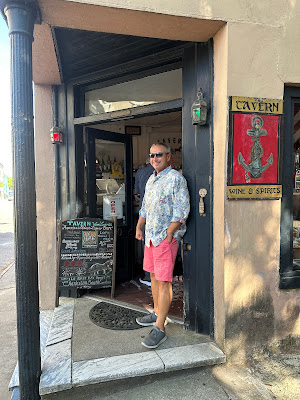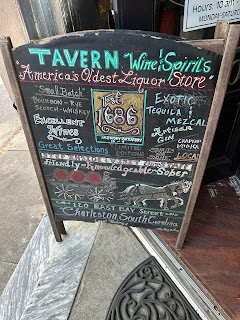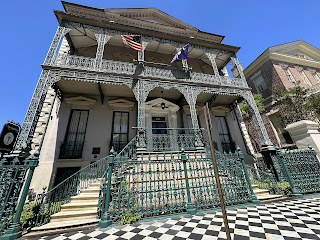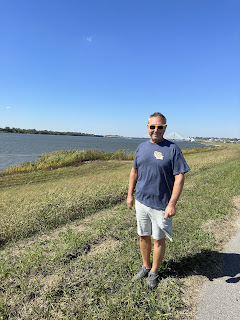Charleston by way of John's Island(MM 465)...
April 7, 2023
Leaving Hilton Head, we planned to stop at Bohickit Market and Marina. The travel and stop were great. We were on the ICW side and .3 miles from the entrance to Kiawah Island. They have a nice shopping area to walk around and enjoy the outside. Many years ago we had been here with the kids but it was much smaller. Schools being out, there were a numbers of families in the area. As we have seen, the dolphins, bird life including this beautiful Bald Eagle continue to make our Loop even more enjoyable. I am somewhat surprised the number of dolphins we have seen far up into rivers where I would think the water would be too fresh. The river did multiple twists and turns allowing us to look at the beautiful houses. We saw some for sale which we looked up and well beyond our budget!
Finally, we approached Charleston and the battery as we came down the Ashley River. Then passing by the tip of the battery, we could finally tie up at the City Marina.
Our planned stop in Charleston was scheduled for 10 days(the most you can stay at the city marina) because of a planned needlepoint class I was taking with Sibby in Sarasota. Unfortunately, it was cancelled a few days prior so we had to do some changes but all worked out just fine. While I was going to be at the class, Danny had scheduled some work to be done. Danny was happy with the mechanic and the work so hopefully, we will be good until Deltaville. Morgan and Charlotte had planned to come to Siesta Key for a few days but drove instead to Charleston. Morgan knows the city much better than us since she went to school here and lived on Isle of Palms for a couple years. The push to get here was due to bad weather to include rain and high winds. While we accomplished the goal of getting tied up or tied down, I should say, the weather was not good. The city marina is downtown(great location) but is affected by northerly winds and commercial container ships all day. The winds of course were north-northeast 20miles+ per hour with gusts of 35 miles for the first 3 1/2 days. I slept upstairs on the sofa with my important belongings in a bag by my side. Yes, I am paranoid and thought being upstairs may help with seasickness. The fact I had to take Ambien to sleep also helped! Danny, of course, had no problems sleeping in the berth. A few hours on the first day we were able to walk around the city but then it was 4 days later before there was any more exploring due to the weather.
Taken from the stern(back of the boat) at the marina before the bad weather. We could see the container ship and the Ravenel Bridge on the Cooper River.
While Danny spent time working with the mechanic, I took a walking tour with the Charleston Historical Society which was fantastic. I learned so much and when the tour was over, returned to those areas to spend more time. This week appeared to be similar to Virginia's Garden Week so the group had multiple trips you could choose from throughout the day. One of the stops was Rainbow Row- the longest cluster of Georgian row houses in the US. These homes date between 1720 to 1790. The preservation of these structures on the outside are remarkable. I can't imagine the inside.
Carolina Colony was given to 8 Lords by King Charles II of Britain which was south of Virginia and north of Spanish Florida from the Atlantic Ocean to the South Seas (ie Pacific Ocean). Charlestown settled in 1670 from settlers coming from Barbados where they had wintered before arriving. Sugar plantations produced sugar and rum in Barbados. These plantations were running out of supplies such as wood. Those 170 settlers come to an area called Albermarle Point, 6 miles up the Ashley River to avoid the Spanish where their ships could not travel due to the shallow water in 1670. About 10 years later, they moved down to the peninsula to what was known as Charlestown. Along the coast of South Carolina in addition to the Spanish with their "slaves" called maroons, there were 26 indigenous groups of people. Carolina Colony charter stated tolerance of all people except Roman Catholics. This was due to both Spanish and French Catholics competing in nearby areas for land. In the historic area of Charleston, you will see cobblestone streets. These stones were not from this area but were ballast stones found in ships from Europe to weigh the boats down to add stability. The model of the city was called the Grand Model where the lots were short on the street and long to the back of the yard and formed a grid.
Charleston had numerous fires over many years. Initially homes were built of wood and after these fires, people would begin to build brick homes. The guide showed us brick throughout the tour where you could see fingertips in the brick. Also in 1886, there was a devastating earthquake. Many homes have what was considered a solution to stabilizing their structures- a steel rod with a bolt on the outside pulling the floors back together and it worked. Some of the roofs were made with gambrel tiles which were made against a person's thigh to form a slight indentation.
St Michael's Church which is the oldest church in the historic area was finished in 1761 and is a beautiful white structue. It is the oldest because it has never been destroyed by fire. There is a special pew(Number 43) in the church for special guests to include George Washington, Marques de Lafayette, Thomas Jefferson, Robert E Lee, Winston Churchill, and Prince of Wales then, now King Charles III. I went in and touched the handle to the pew after services on Sunday so I can say I touched the same opening these men did! One of the members of the church was kind enough to give us a tour and show us the Tiffany windows which were beautiful. The bells of the church are still rung by hand today. The wood throughout the church is walnut and absolutely beautiful.
I also went inside the Catholic Church which was also beautiful. While on the tour, I also enjoyed looking for and taking pictures of wrought iron fences throughout the historic area. Phillip Simmons who was the famous artist in wrought iron fences throughout not only Charleston but the world. Our guide told us he preferred to do work in any color but black as it reminded him of mourning. The majority of his work though was done in black.
The Rutledge Inn, now a B&B which belonged to a signer of the Declaration of Independence had the wrought iron fences in green. Our guide said the small pink house was typical for Charlestown in mid 1700's. This house was built with wood and gambrel tile style. It has been shown to have once been inhabited by a pirate. It is currently privately owned and being redone. She said a well known gardener was doing the gardens in the back.
In Charleston, anything could be sold on any street corner as well as the City Market except the selling of human beings could not be sold at the City Market. In 1856, the selling of individuals was taken inside due to the "politics" of the time. There is one Slave mart still standing for tours on Chalmers Street. Unfortunately, I did not get to this but will return.
The South Carolina flag is a deep blue for the indigo grown in the area. Indigo was a blue dye sold worldwide in colonial times. The trunk of the palmetto tree was used to build walls of a fort out on Sullivan's Island to protect the area from the British during the American Revolution. The British cannonballs hit the trunks of the trees and the Americans used those cannonballs to shoot back because they caused no damage. It is considered the first naval victory of the American Revolution for the Americans. The officer in charge of the troops was Moultrie who was raised to a General and the fort named Fort Moultrie after this victory. The state flag also has the Palmetto tree for this reason. The last item is a crescent moon.
We saw the outside of the Exchange and the Dungeon. This was the customs house and the last building built by the British in 1771. The British arrested South Carolinian men who plotted against them and sent them to the dungeon at the bottom of the building which was under sea level. You can see in the picture below, the windows at the street level. After being imprisoned here, they were exiled to St Augustine and lost their property. What was interesting to me was this building at the back is where the Charleston Harbor was in 1771. The filled land goes on for at least 4 blocks to the water now. The guide said Charleston was second only to Boston in filled land in the United States.
There were a number of craftsmans making sweetbread baskets throughout the city which were beautiful. The baskets are made of sweetgrass which is a long-stemmed plant that grows in the marshes of the sea islands from South Carolina to Florida. The sweet grass is coiled with strips of leaves from the native Sabal Palmetto trees and with pine needles from the longleaf pine.
When Morgan arrived, we drove out to the Angel Oak, a 400+ year old live oak. I took pictures of Morgan and Danny here when she was in college so I wanted another picture to include Charlotte. It is massive!
During our time here at the marina, a large barque (pronounced bark) ship, named Gunilla was tied up on the outside pier. The barque ship relates to the the design of the rectangle sails on the 2 masts. The ship was built in 1940 and redone into a barque ship in 1997. It is from Sweden and carries students from there for 3 month increments for seamanship school. They arrived here from the Bahamas and will leave a couple days after us to go to Bermuda then the Azores. The students on now will get off in Iceland and the next group will get on there until they return to Sweden. Very nice people with the students having varying degrees of understanding English. The"nice" picture is off their internet site since the boat with us did not have the sails up.
We enjoyed eating throughout the city. When we initially got here, I thought I would do taste testing of she crab soup and crab cakes. I was disappointed. We ate at Revival which was good but we went to our reliable Hank's for 3 of the evenings we had dinner out. Danny had it all figured it out- flounder, tuna, grouper which he called the trifecta. For me, it was crab, scallops, and flounder not to mention great wine as well. Morgan enjoyed oysters. Building continues all over the city and the prices, well shocking.




































Comments
Post a Comment